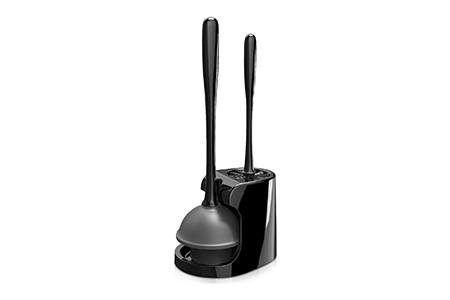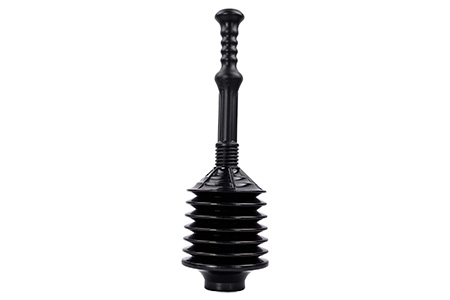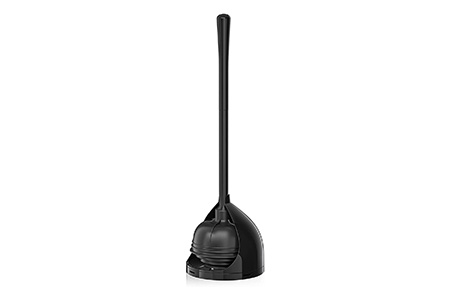9 Types of Toilet Plungers to Clear the Blockage
Author: Omar Alonso | Editor: Omar Alonso
Review & Research: Jen Worst & Chris Miller

All the different types of toilet plungers are indispensable parts of a house, helping you clear out clogs and drains easily. Sometimes, however, you might find that your plunger is just not doing its job.
This might be because you don’t have the right type of toilet plunger. There are various kinds of toilet plungers meant to serve different purposes and functions, which is why you must choose one that suits your requirements.
9 Types of Toilet Plungers
Take a look at some of these toilet plunger types so that you can get a better understanding of them and choose the one you feel will work the best for your situation. Stop wondering if a toilet will eventually unclog itself and take proactive measures with one of the plungers below.
Flange Plunger

Flange plumbers are some of the most ideal kinds of plungers when it comes to toilets. These plungers contain a wooden rod that can serve to provide you with a good grip. Despite the name, these are not types of toilet flanges, which are a different part altogether used to create a seal during installation. The "flange" part of the name refers to the shape and build.
At the base is the cup that is made from rubber, below which is another rubber section called the flange. This flange can make the process of clearing the clog in your toilet much simpler.
By holding the other end of the wooden rod, you can lower the plunger into the toilet with the flange meeting the water first. Hold the plunger down in place and keep a tight grip so that the flange and the cup can help create the suction.
You can then keep moving these types of plungers while ensuring that the toilet water remains in the cup. Make sure the base of the flange covers the drain hole well enough. Ideally, after a few times of ramming the plunger, the clog should clear up.
Flange plumbers are also convenient in the sense that they contain a hole that can clear the cup of the excess water so that it doesn’t make a mess elsewhere, and they work universally well with any types of toilets.
Cup Toilet Plunger

Cup plungers are the standard or traditional kinds of plungers and are the most basic. These are the most common plungers that you’ll be able to find in the stores around you. These plungers contain the usual wooden rod that you can use to maintain your grip and carry out the thrusts over the drain.
Note that the rod can also be made from other materials such as metal or plastic depending on the kind and brand of the plunger that you buy for your toilet. The cup, on the other hand, is usually always made from rubber due to the suction that it can create.
The cup of these types of toilet plungers is a simple inversion at the base of the rod that can flatten up and create a tight seal whenever you lower it in your toilet. It's like a more basic version of the flanger plunger.
However, cup plungers aren’t as effective as some other kinds of toilet plungers since they might not always be able to adapt to the shape of the toilet, resulting in a looser seal.
Beehive Plunger

Beehive plungers have wooden, metal or plastic rods in place along with a rubber cup. Instead of a typical cup, however, the rubber part of the plunger is shaped like a beehive, thus earning it its name.
This rubber part on these plunger types starts off narrow, widens up a bit in the middle and then tapers back into a narrow shape at the end. This tapering end at the lower base of the plunger is the part that you can insert first into the toilet.
Once you do this, all you need to do is rely on the wider part in the middle to create the seal and then ram the plunger up and down for the suction to form successfully. For the lazy like me, you won't even need to lift whatever types of toilet seats you have, since it'll fit right in there.
Because of the shape of this kind of toilet plunger, you can go deeper into the drain and unclog it in a more effective manner. Quite often, the rod of this plunger can also have an upper horizontal handle that you can hold on to for applying a bit more pressure.
Accordion Plunger

Accordion plungers (also called bellows plungers), apart from the gripping rod, have a unique rubber part. Similar to the beehive shape, the accordion plunger starts off with a narrow part, moves to a wider center and tapers back down at the base again.
The base is similar to a flange, which can help create a tight seal. However, the precise shape resembles the accordion instrument, featuring ridges and grooves throughout the rubber element.
When you apply pressure to it, the ridges will come together, just as they would while playing the accordion. These can be pretty useful when it comes to unblocking the drain since you can manage to flush everything out because of the tightness and the much higher volume of air and water you're pushing.
These types of toilet plungers can, however, involve quite a bit of effort on your part. Moreover, you’ll also need to be careful and thorough while cleaning this plunger because the gaps between the ridges can get quite dirty.
Automatic Plunger

Automatic toilet plungers are now becoming more and more common due to the convenient and relatively effortless result they can provide. These plungers tend to follow the standard rod and cup/base structure, but instead of ramming them up and down after you form the seal, all you need to do is hold it in place.
On the SurePlunge model, the base has a tapering tip that can release carbon dioxide from a cartridge into the drain, thus clearing it up efficiently and thoroughly. This can be useful since you can simply carry the procedure out once and not have to repeat it any time soon due to its longevity.
However, you might need to keep stocking up on the carbon dioxide cartridges, which can end up making the whole thing a bit more expensive.
There is another kind of automatic plunger called a power plunger which simply pulls the water in and out, so all you need to do is press the trigger.
Tiered Plunger

Tiered types of plungers for toilets can be another good choice for your toilet. It involves a wooden, metal, or plastic rod, although it can be better to avoid wooden rods in this case since the wood can become much dirtier in a very short period of time.
The rubber element of this plunger includes a simple rubber cup. This cup then moves on to tiers or flat layers that can fold together and assist the rubber cup in creating a tighter seal and suction, allowing you to easily clear out the clog in an easy manner.
A good thing about this kind of plunger is that it is versatile, so even if you have other kinds of drains and toilet shapes in your house, you can easily use this plunger for them, no matter what types of toilet flanges, shapes, and sizes are installed..
Hybrid Plunger

Hybrid toilet plungers are modified versions of your standard plungers. They usually tend to combine elements of different kinds of plungers or change up some part of the plunger so that you can have an easier time unclogging the toilet.
For instance, some toilet plungers can feature a relatively shorter handle that is also made from rubber, allowing you to cover a deeper part of the drain and have a bit more flexibility in the motion that you use.
Some rubber sections on these different types of toilet plungers can also be bigger in size, with many opting to use an accordion design so that the effect is more pronounced. Some also have a pump that can create a vacuum.
Touchless Toilet Plunger

Touchless plumbers are different from all the other plungers on this list. It doesn’t follow the typical structure of a plunger at all. In fact, it completely gets rid of the rod so that all you have is a large rubber sheet or sleeve that works similarly to the accordion plumber.
All you need to do here is place it between the toilet seat and the bowl. Instead of using a rod to move the rubber element up and down, you have to pull and push the entire toilet seat so that the suction can form.
A similar version of this touchless plumber is the disposable plunger types that are made from plastic. It is touchless in the sense that you don’t have to deal with the rod and rubber part, but you’ll have to hold a sticker down over the toilet seat, flush the toilet and keep pressing to form a seal.
While you can try either of these out, they aren’t as effective and clean as the other plungers. They seem appealing since they're the most different types of plungers, but you can't really push enough pressure through the drain to dislodge blockages with these. It is nice to not have to put anything into the brown toilet water, if you catch my drift.
Taze Toilet Plunger

Taze toilet plunger types are toilet plungers that professional plumbers usually carry and use. They aren’t something you should try out on your own, especially since many of them are meant for pipes that are much bigger in size.
These types of plungers come in the form of a small disc attached to a steel pipe or rod that the plumber uses to insert the disc into the pipe. This can allow the disc to form a tight seal and suction that can then help clear and unclog the pipe. You are unlikely to find these plungers easily.
Types of Toilet Plungers to Unblock the Mess
The main kinds of toilet plungers are flange, cup, beehive, accordion, automatic, tiered, modified, touchless and taze. Each of them is meant to be useful for its own function, which is why using them for multiple purposes might not always help you. Choose the right option from these diffreent types of toilet plungers that will be perfect for your toilet to prevent any hassles later on.



